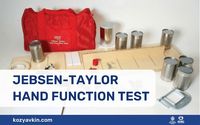Jebsen-Taylor Hand Function Test is one of the oldest and most commonly used tools for quantifying motor function of the hand. Developed in 1969 by a team of American researchers, the test has proven its validity and reliability.
Jebsen-Taylor test was developed primarily for patients with cervical spinal cord injury, but due to its simplicity and practicality has become widespread in the functional diagnosis of stroke, cerebral palsy, rheumatoid arthritis, carpal tunnel syndrome and other diseases and pathological conditions accompanied by limitation of upper extremity function.
The target group of patients for this test are people with diseases of the nervous and musculoskeletal system who have hand dysfunction. The tool can be used for persons over 5 years of age and the patient should be able to understand the instructions. The test is not recommended for people with speech disorders, as well as after surgery on the upper extremity, as the reliability and validity of the test in this category of patients is questionable.
The test covers components from the categories of activity and functioning of the International Classification of Functioning, Disability and Health (IFF). The authors tried to make the test as practical as possible, that’s why it assesses performance of tasks typical for the patient's daily activities.

The test includes tasks that assess fine hand motor function and functional tasks with and without weight. It consists of seven subtests, which are performed on time:
- Writing a short sentence (24 letters, 3rd grade reading difficulty)
- Turning over a 3×5-inch card,
- Picking up small common objects (coins, paper clips and metal bottle caps) and transferring them into a container,
- Simulated feeding (by collecting beans with a spoon and transferring them into a container),
- Stacking checkers,
- Picking up and transferring large light objects (empty cans)
- Picking up and transferring large heavy objects (cans with weight of 0.453 kg).
Each task is performed with one hand, first non-dominant, then dominant. The maximum time allotted for one subtest is 120 seconds. The test only evaluates the speed, but not the quality of the tasks.
Subtest "Writing a short sentence " is not performed for patients under 8 years of age.
The test can be performed by both a clinicians and parents, no special training is required. When assigning tasks, follow the instructions with a clearly defined scenario. The instruction is available in English, Portuguese and Ukrainian.
The test takes an average of 15-45 minutes to complete, depending on the experience of the person conducting the assessment and the patient's condition. The test kit can be ordered online or assembled yourself.
The score for the subtest is equal to the time in seconds required to complete the task, the maximum score for the subtest is 120. The total score is equal to the sum of points for all subtests and is calculated separately for each hand. The lower the score, the better the child's hand function.
Evaluation is performed by comparing the patient's results with the standards established for the appropriate age and sex. Both the total time for the test and the results of each of the seven subtests are compared separately. The calculation is performed according to the following formula:
Result = (Normative Time - Patient Time) / Standard Deviation
A result greater than 2.0 indicates that the patient is performing the task too slowly, which means that the motor function of the hand is impaired.
It should be noted that the norms are established in the sample of persons with the non-impaired function of the upper extremities, so the reference to the normative data in patients with pronounced motor disorders is not always informative. Instead, for such categories of patients, the test can be an effective way of monitoring the dynamics, for example, by comparing the results before and after the treatment.
The regulatory framework and a detailed description of the test can be found on the website Rehab Measures.
You can watch a video with a test demonstration in English by this link.

